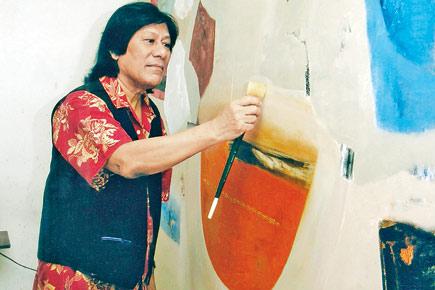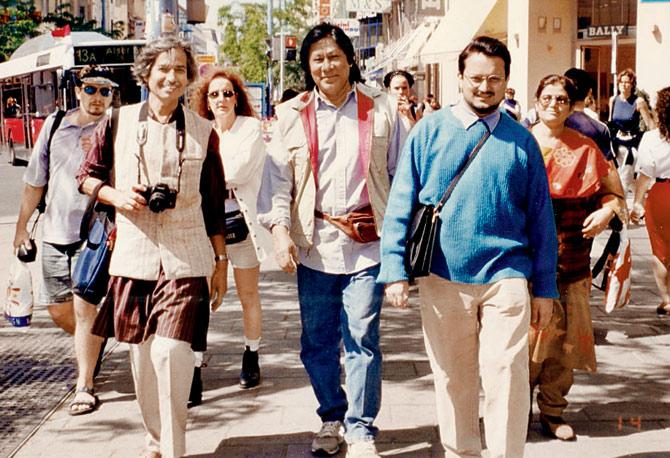Ahead of a two-part exhibition of works by Laxman Shreshtha, curator Ranjit Hoskote converses with the artist

Laxman Shreshtha
The Infinite Project is a celebration of Laxman Shreshtha’s work, tracing a retrospective arc across his work from the 1960s to the present. Fittingly, the works gathered to form this exhibition are drawn from the collection of Jehangir Nicholson, who was both a dear friend of the artist and a dedicated champion of his work. The Nicholson Collection boasts of 49 works by Shreshtha, the earliest dating back to 1963 and the most recent one to 2008. This is arguably one of the most substantial representations of Shreshtha’s oeuvre in a single collection.
ADVERTISEMENT

PIC/JEHANGIR NICHOLSON ART FOUNDATION
Abstraction, by its very nature and definition, is a continuing process, an open-ended activity in a field mined with surprise and difficulty; the abstractionist’s work is never done.
It is to honour the abstractionist’s commitment to [an] ongoing and indeed ceaseless mandate that I have titled this exhibition The Infinite Project. The Infinite Project may be seen as a viewing platform to survey the phases of the journey that Shreshtha has made since his student years at the Sir JJ School of Art, Bombay; the École Nationale Supérieure des Beaux Arts, the Academie de la Grande Chaumiere, and S W Hayter’s Atelier 17, Paris; the Central School of Art, London; and his first exhibition, held at the Taj Art Gallery, in Bombay’s iconic Taj Mahal Palace hotel, in 1963. Structured in two phases, the exhibition presents his trajectory along a chronological axis, from 1963 to 1988 and from 1988 to the present.

Shreshtha with collector Jehangir Nicholson at the latter’s home
I have had the privilege of knowing Shreshtha since the early 1990s. We had our first long conversation in 1994, when I visited his studio for the first time and it was the first of many conversations that would follow.
Shreshtha’s art has been sustained by a series of encounters and conversations, a brief and abstract chronicle of which I will attempt here:
RH: Tell us about the conversations that you’ve had over the years with fellow artists in Bombay. With Akbar Padamsee, with Tyeb Mehta earlier and then, through the years, with Gaitonde? What were those conversations like?
LS: I wanted to settle down in Bombay because I started to get a little tired of the attitude of the artists in Europe. Whenever they met, they talked about which gallery had selected you, where are you having the exhibitions; nothing about the work. Nothing about what you are reading, what you are thinking but about the successes with galleries and commercially. In Bombay, I used to meet people like Ambadas, especially Barwe. I used to find that this is the place to paint really. Nobody is in a hurry. Barwe used to say, “What is the hurry? Why paint so many?” I thought this is the place that I want to be. So I was happy that I settled in Bombay and then slowly I came to know [MF] Husain, and then [VS] Gaitonde very well. Akbar [Padamsee] became very good friends for a few years and he used to come to my studio twice, thrice a week and two, three times he used to call us to his studio. [These artists] really are saints because they are so pure. And it was very educational. I really evolved in the company of these people.
 Jogen Chowdhury, Laxman Shreshtha and Ranjit Hoskote in Vienna, Austria 1998. Pic/Laxman Shreshtha
Jogen Chowdhury, Laxman Shreshtha and Ranjit Hoskote in Vienna, Austria 1998. Pic/Laxman Shreshtha
RH: There was no sharp distinction between the figurative, the abstractionists, the symbolic. What seems most important about that whole period is that artists were willing to talk about their work without emphasising the so-to-speak stylistic differences. It was more important to look at the depth and the intensity of the work.
LS: Not much happened. There were only a few galleries. And a few painters met and talked to each other. So ‘figurative painter’ and an ‘abstract painter’ did not differentiate; they could sit in the same place and discuss about the same problems they have with their paintings. But I think there was a difference. It was almost like two different classes. Which it did become later, when articles about art were being written and there were many galleries where the shows were selected in certain ways. It was curated as figurative or some theme and then it did separate.
RH: You’ve often talked about the quality of silence in the works of Gaitonde and in your own work. And somehow
that seems to be a very important centre of gravity. The resonant nature of silence in a painting.
LS: I met Gaitonde in my last year as a student. And slowly, by many accidents, we became very good friends. He once invited me to Bhulabhai Institute and he gave me the time. It’s quite unusual that he would ask somebody to come and see him. He was sitting on the wooden bench and only two people could sit at the entrance of Bhulabhai. And in front of that there was sea. He said, “Laxman, come and sit here.” We saw the sun set. We didn’t say anything. Later, at his studio, he told me, “Laxman, you know why you are my friend.” I didn’t say anything. He continued, “Because you know the value of silence.” I was very intrigued because I wasn’t silent; I was silent in front of him. I was a very boisterous man. My first reactions are of tremendous colours. But Gaitonde used to talk to me in a very special way. So that really changed me. Silence is very necessary for a painter. How will you reach the source otherwise? If you have an abstract painter’s attitude, you are searching for the source.
The Infinite Project opens at the Jehangir Nicholson Gallery, CMSVS, on August 18 and ends on October 3. Excerpts from the curatorial essay and interview published with permission from Jehangir Nicholson Art Foundation
 Subscribe today by clicking the link and stay updated with the latest news!" Click here!
Subscribe today by clicking the link and stay updated with the latest news!" Click here!








